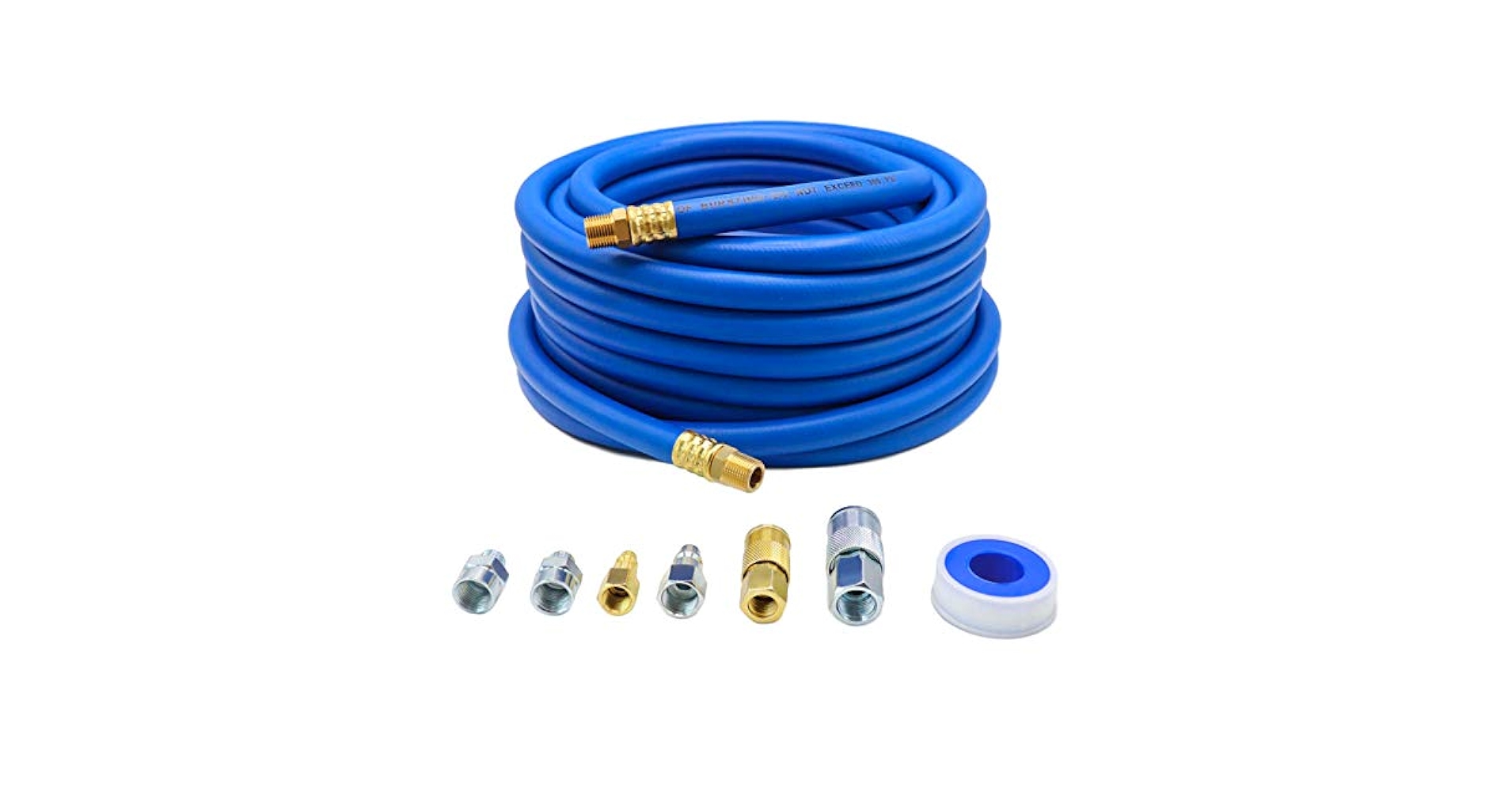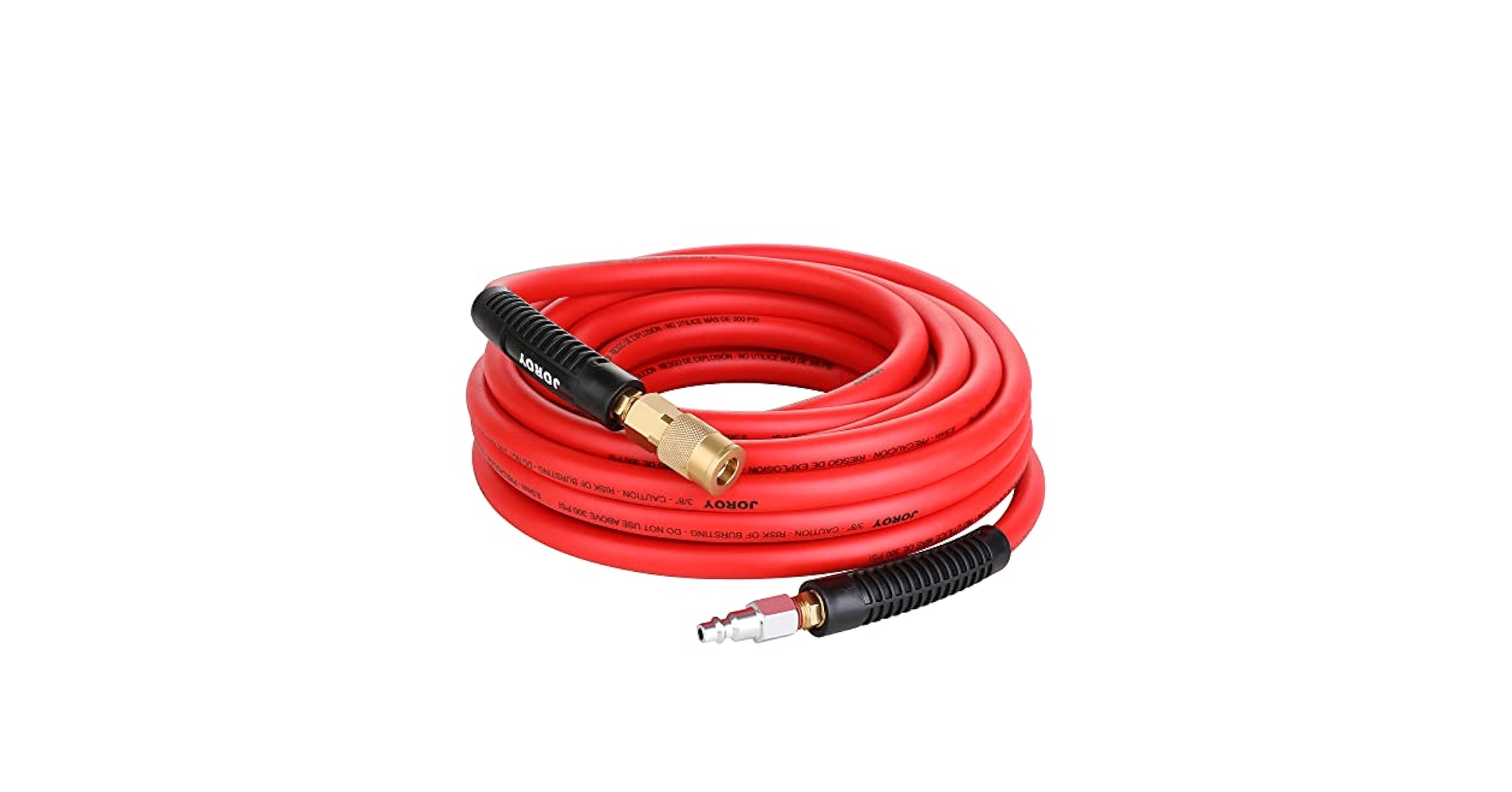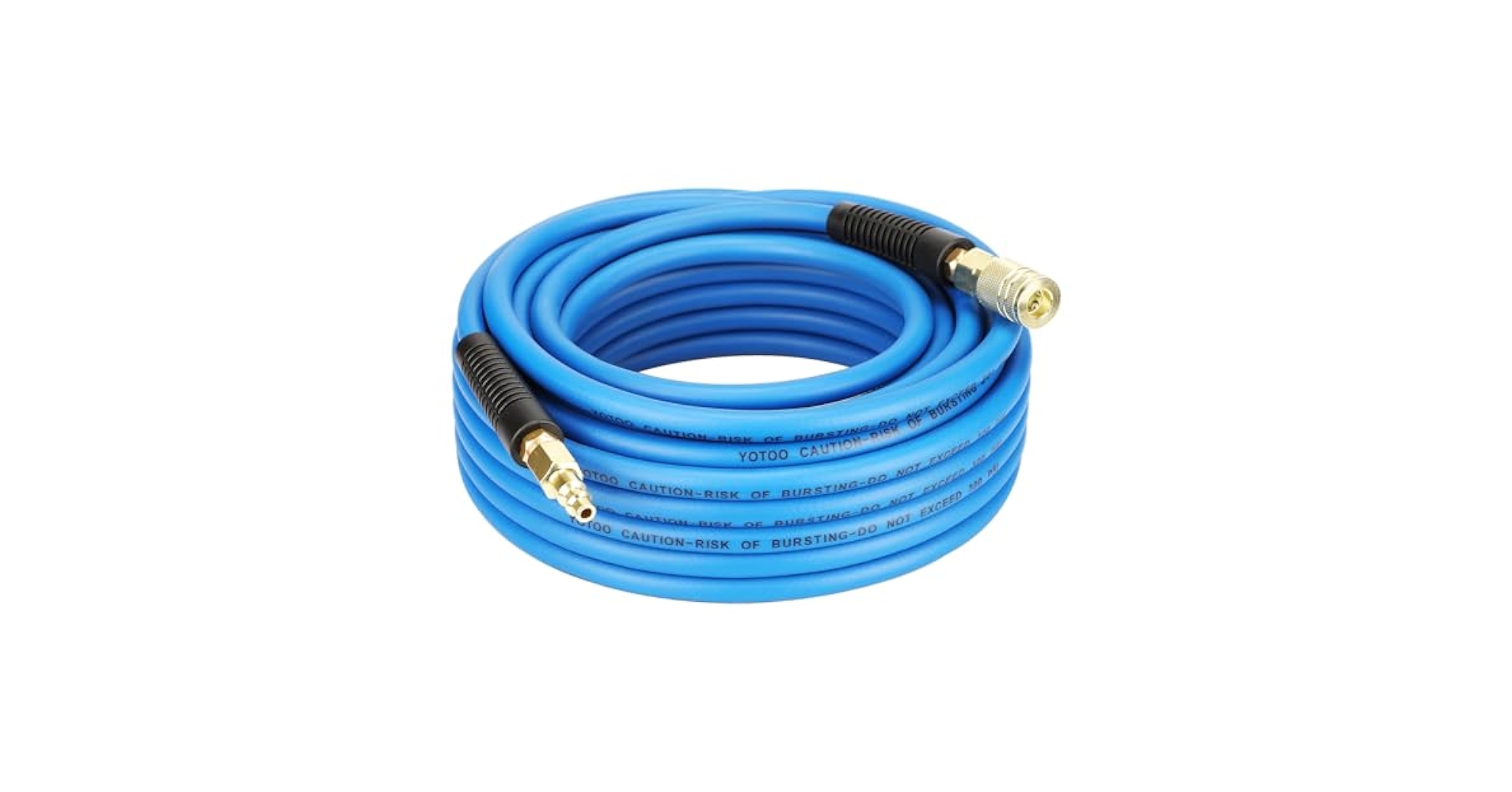Choosing the right air compressor hose size can make a huge difference in how well your tools work. If your hose is too small, you might feel frustrated by low pressure and slow performance.
Too big, and you could waste money and deal with unnecessary hassle. You want your air compressor to run smoothly, delivering just the right power when you need it. You’ll discover exactly how to pick the perfect hose size for your needs—so you get the best results every time.
Keep reading to find out what really matters when it comes to air compressor hoses.

Credit: www.amazon.com
Air Compressor Hose Basics
An air compressor hose connects the air compressor to tools or equipment. It carries compressed air safely and efficiently. Choosing the right hose size and type is important for performance and safety.
The hose size affects air flow and pressure. A wrong size can reduce tool power or cause damage. Understanding hose sizes, materials, and types helps pick the best hose for any job.
Common Hose Sizes
Air compressor hoses come in different diameters. The most common sizes are 1/4 inch, 3/8 inch, and 1/2 inch. Smaller hoses work well for light tools and short distances. Larger hoses deliver more air for heavy tools and long runs.
Choosing the right size depends on the tool’s air needs and hose length. Bigger sizes reduce pressure loss and improve tool performance.
Materials Used
Hoses are made from materials like rubber, PVC, and polyurethane. Rubber hoses are strong and flexible but heavier. PVC hoses are lightweight and cheap but less durable. Polyurethane hoses offer good flexibility and last longer.
The material affects the hose’s durability, weight, and flexibility. Pick a material that suits the work environment and tool use.
Types Of Hoses
Different hose types serve different needs. There are general purpose hoses for everyday use. Heavy duty hoses withstand tough conditions and high pressure. Coil hoses retract easily and save space.
Each type has advantages. Choose based on how and where the hose will be used.

Credit: www.amazon.com
Choosing The Right Hose Diameter
Choosing the right hose diameter is key for your air compressor setup. The hose size affects how air flows, the pressure you get, and how well your tools work. Picking the wrong size can cause problems and waste energy. This section explains why hose diameter matters and how to select the best size for your needs.
Impact On Airflow
The diameter of the hose controls the amount of air passing through. A larger hose allows more air to flow freely. This means your tools get enough air to perform well. A smaller hose limits airflow. This can make your tools weaker and slower. Choosing the right diameter keeps the air moving smoothly.
Effect On Pressure Drop
Pressure drop happens when air loses power traveling through a hose. Smaller hoses cause more pressure drop because of tight space. This lowers the air pressure at the tool end. Bigger hoses reduce pressure drop. They keep the pressure steady and strong. The right size hose keeps your tools running at full power.
Matching Hose Size To Tools
Every tool needs a specific air volume to work well. Check your tool’s air requirements before picking a hose. Use a hose that matches or is slightly bigger than the tool’s needs. Too small a hose means less air and poor tool performance. The right hose size helps tools work efficiently and last longer.
Length Considerations
Choosing the right length for your air compressor hose is important. Too short, and it may not reach your work area. Too long, and it could reduce the air pressure. Finding the right balance helps your tools work better and saves you effort.
Length impacts how well your air tools perform. It also affects how easy it is to move around while working. Understanding these points can help you pick the best hose length for your needs.
How Length Affects Performance
Longer hoses cause more air pressure loss. The air has to travel farther, which reduces its force. This can make your tools run slower or weaker. Short hoses keep pressure steady and tools strong.
Too long a hose also means more chance for leaks. Each connection can lose some air. This lowers the overall performance of your system. Use the shortest hose that still fits your workspace.
Balancing Reach And Efficiency
Think about how far you need to work from the compressor. The hose should be long enough to reach without stretching. Stretching can damage the hose and cause leaks.
At the same time, avoid buying a hose that is much longer than needed. Extra length adds weight and makes handling harder. It can also reduce air pressure and efficiency. Choose a length that balances freedom of movement with strong airflow.

Credit: www.amazon.com
Hose Construction And Durability
Air compressor hoses need strong construction to handle pressure and last long. The way a hose is built affects its strength and flexibility. Durable hoses resist wear and keep air flowing smoothly. This section explains key parts of hose construction that improve durability and performance.
Reinforcement Layers
Reinforcement layers give the hose extra strength. These layers often use braided or spiral fibers. They help the hose hold shape under high pressure. Reinforcement stops the hose from bursting or stretching. This makes the hose safer and more reliable for tough jobs.
Resistance To Kinks And Abrasion
Hoses must resist kinks to keep air flowing freely. Kinks block air and can damage the hose. Good hoses use flexible materials that bend without folding. Abrasion resistance protects the hose from rough surfaces. It prevents cuts and scrapes during use. This keeps the hose working longer and reduces repairs.
Fittings And Connections
Fittings and connections play a key role in air compressor hose size. They join hoses to tools and machines. Good fittings keep air pressure steady. Poor connections cause leaks and waste air. Choosing the right fittings helps the system work well. It also extends the hose life. Understanding fittings types and how to seal them is important for any setup.
Compatible Fitting Types
Many fittings fit air compressor hoses. Quick-connect fittings allow fast tool changes. They snap on and off easily. Threaded fittings screw tightly to avoid leaks. Push-to-connect fittings hold the hose firmly. Brass and steel are common fitting materials. Brass resists corrosion and lasts long. Steel offers strong, heavy-duty connections. Choose fittings that match hose size and pressure needs. Correct fittings ensure safe and smooth air flow.
Ensuring Leak-free Connections
Leaks reduce air pressure and waste energy. Tighten fittings securely but do not over-tighten. Use thread seal tape on threaded fittings. It fills small gaps to stop leaks. Check fittings regularly for wear or damage. Replace cracked or bent fittings quickly. Clean fittings before connecting to avoid dirt. Proper connection prevents air loss and keeps tools working well. A leak-free system saves money and time.
Maintenance Tips For Longevity
Maintaining the right air compressor hose size helps keep your system working well. Proper care extends the hose’s life and saves money. Small habits make a big difference in durability.
Proper Storage Practices
Store hoses in a cool, dry place. Avoid direct sunlight to prevent cracking. Hang hoses on hooks to stop kinks and bends. Keep them away from sharp objects and chemicals. Coil hoses neatly without twisting. This prevents damage and keeps air flowing smoothly.
Regular Inspection And Cleaning
Check hoses for cracks, leaks, or wear often. Look at connections for tightness and corrosion. Clean hoses with a damp cloth to remove dirt. Do not use harsh chemicals that can weaken the hose. Replace damaged hoses immediately to avoid failure. Regular checks keep your air compressor running safely.
Common Mistakes To Avoid
Choosing the right air compressor hose size is very important. Many people make simple mistakes that cause poor performance and damage. Avoiding these errors saves time and money. Learn about the common mistakes to avoid for better results and longer hose life.
Using Incorrect Hose Size
Using a hose that is too small limits airflow. The compressor must work harder. This lowers efficiency and can cause overheating. A hose that is too large wastes space and is hard to handle. It also reduces air pressure at the tool. Always match the hose size to your compressor and tools.
Ignoring Pressure Ratings
Each hose has a maximum pressure rating. Using a hose with lower pressure than needed is unsafe. It may burst or leak. This can cause injury and damage equipment. Check the pressure rating before buying. Choose a hose that meets or exceeds your compressor’s pressure output.
Upgrading Your Air Compressor Hose
Upgrading your air compressor hose can improve your tool’s performance. Choosing the right hose size matters a lot. The right hose size helps your tools work better and last longer.
Benefits Of Larger Diameter Hoses
Larger diameter hoses allow more air to flow through. This means your tools get more power. They reduce pressure loss over long distances. You can use bigger tools with less effort. Larger hoses also prevent overheating in the compressor. This keeps your system running smoothly.
When To Replace Your Hose
Replace your hose if you see cracks or leaks. Worn hoses reduce air pressure and tool efficiency. If the hose feels stiff or hard, it may be old. Also, replace if the hose size no longer fits your tools. Using a damaged hose risks safety and performance. Regular checks help avoid unexpected problems.
Frequently Asked Questions
What Is The Ideal Air Compressor Hose Size?
The ideal hose size depends on your tool’s air demand and compressor capacity. Generally, 3/8-inch hoses suit most tasks. Larger tools or longer hose runs may require 1/2-inch hoses to maintain proper airflow and pressure.
How Does Hose Size Affect Air Compressor Performance?
A smaller hose restricts airflow, causing pressure drops and reduced tool efficiency. Larger hoses provide better airflow but can be heavier and less flexible. Choosing the right size balances performance and convenience.
Can I Use Any Hose Size With My Air Compressor?
Not all hose sizes work for every compressor or tool. Always match hose diameter to tool requirements and compressor output. Using incorrect sizes can reduce efficiency and damage equipment.
Why Is Hose Diameter Important For Air Pressure?
Hose diameter affects airflow volume and pressure stability. Smaller diameters create more friction, lowering pressure. Larger diameters reduce friction and maintain consistent pressure for better tool performance.
Conclusion
Choosing the right air compressor hose size helps your tools work well. A smaller hose may limit air flow and cause problems. A larger hose can keep air flowing smoothly and improve performance. Think about the length and the tool’s needs before buying.
Proper hose size saves time and energy. It also keeps your equipment safe and lasting longer. Remember, the right hose size means better results and less hassle. Take your time to pick the best fit for your work.

